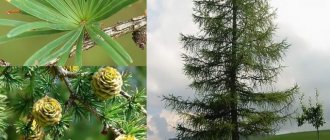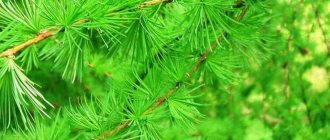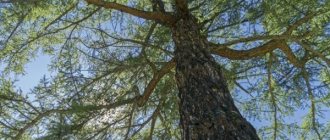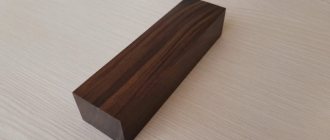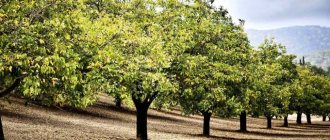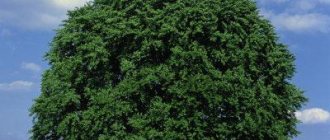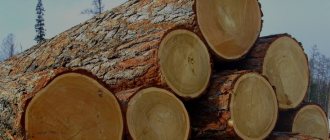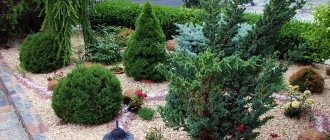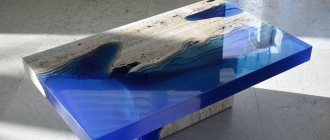- Reports
- Plants
- Larch
Larch is one of the most common tree species in Russia. Everyone living in the middle zone has seen this tree. Larch is a beautiful tree that is widely used for household needs.
Description of the breed
Larch is a coniferous tree. It belongs to the pine family, and its closest relatives are spruce and pine.
The height of the larch is 40 meters; there are also specimens reaching a height of 50 meters. This tree has a smooth trunk, the diameter of which can reach 1 meter or more. Young larch has light bark, and the crown is narrowed upward. Mature trees have a spreading crown and gray, gray-brown bark.
The roots of the tree grow securely into the soil. There is no taproot - the rhizome system is branched.
Peculiarities
The tree grows quickly and can grow even a meter in a year. Larch lives for a very long time - 500-600 years.
In winter, the tree, unlike its relative spruce, sheds its needles. After the onset of spring, the branches are again covered with bright needles.
Larch is soft to the touch, its needles do not prick, like spruce needles.
The tree reproduces by seeds. At the same time, it is monoecious - both “female” cones and “male” spikelets grow on it.
Larch thrives in any climate and in any weather conditions. It easily tolerates both frost and drought. Resistant to diseases and various pests.
However, sunlight is very important for larch. In the dark, the tree may wither.
To date, 20 species of this breed are known. Larch is found everywhere, and not only in Russia, but throughout the world. She feels great next to fir, spruce and birch.
Uniqueness
Larch has a number of unique properties known since ancient times. This is a very durable breed. The beautiful city of Venice stands on stilts made from this very tree. Over the centuries, the tree has not rotted or been damaged in any way.
Breed properties:
— larch is resistant to moisture;
- she is not afraid of insects;
- contains a large amount of resin;
- characterized by strength, elasticity and longevity.
Due to its excellent characteristics, this type of wood has long been used in shipbuilding and manufacturing. Bridges, piers and dams were and are being built from it.
Wax, rosin and acetic acid are obtained from larch. Larch makes it possible to obtain synthetic silk and stockings, dyes are produced from it, and even the needles of this species, rich in vitamin C, are used for medicinal purposes.
Larch unusual coniferous tree grade 5
Report No. 2
Larch is a coniferous tree that belongs to the pine trees. Larch is quite popular in our area and grows mainly in the northern part of the country. The approximate age of most of these trees is about 400 years, but sometimes they are more than 8 centuries old. In favorable conditions, larch grows up to 50 meters, and the tree trunk in diameter can reach 1 meter. Young larches have crowns somewhat similar to a cone. And mature trees have looser crowns with gaps, so the sun's rays can pass between them unhindered.
The tree begins to bear fruit with the help of cones that are red in color. Larch seeds ripen in these cones, but they sprout and ripen rarely and for a long time. The pine tree bears fruit abundantly once every 7 years. A deciduous tree can normally tolerate low temperatures, and in the far north it can tolerate temperatures down to -60. But coniferous trees do not tolerate strong windy weather. Larch has a shallow root system, so strong winds can negatively affect the tree.
Other facts about Larch
1) Larch is rightfully considered a unique tree because this wood is very durable. After all, log houses made of this wood can last for centuries. Also, deciduous wood is an excellent material. But it is worth remembering that larch logs are not suitable for rounding, since this destroys the protective layer on top of the tree. Most houses and much more are built from larch logs. This pine tree can be purchased in stores. In the Moscow region there are many varieties of larch.
2) Another advantage of larch is that the tree does not rot due to dampness and hardens in water. Coniferous tree trunks are used as strong piles.
3rd grade, 2nd world around, 5th coniferous tree, 6th in biology, 7th grade
Growing larch
Larch is a very resistant plant; severe frosts and severe droughts cannot break it. Larch is sensitive to sunlight; it requires sufficient land area and moist, loose soil.
The presence of minerals in the soil does not greatly affect the growth of the tree. As fertilizers, ash, dolomite or lime are contraindicated for larch.
How to grow larch bonsai
- If you want to grow a bonsai from larch, it is planted in a certain mixture, which consists of peat, compost and sand. The required proportion is one to one. The height of the containers for planting must exceed 6 cm.
- When summer comes, the larch is taken outside. Lack of fresh air and sunlight will make the plant weak. In winter, larch needs to create certain conditions. They are usually created in a separate room. This applies to maintaining the right amount of moisture and lighting.
Attention! Larch in the wild lives in areas with climate change and therefore needs low temperatures in winter. During hibernation, the temperature should be no more than 3 degrees Celsius.
Tree care
Describing larch in detail, it must be said that due to the unique properties of this plant, pests are not afraid of it. Strong, thick and resinous wood creates a natural barrier against pests.
When growing larch at home, beneficial substances are added every month, once, regularly, starting from April and ending with the end of August. Almost any fertilizer that is used for ordinary bonsai is suitable as a useful fertilizing.
The method of propagating larch at home involves collecting and planting seeds in the ground..
- As summer comes to an end, the larch cones will ripen and open, releasing the seeds.
- Be careful, they are easily blown away by the wind.
- Plant seeds without delay, after collection.
Attention! It must be remembered that seeds have low germination rate, and as a guarantee of success, it is necessary to sow as many of them as possible.
Popular message topics
- Information modeling
A model (substitute object) is an object that replaces a real object (prototype, original). Among other things, we can say that any visual aid can be called a model. - Water
Water is the main substance without which no living organism can live, and water is also combined with two chemical elements. Its chemical formula is HO. Water is a colorless substance that has neither taste nor smell, - Art of Ancient Egypt
Egypt has a rich history and culture. First of all, Egypt is associated with pharaohs and ancient pyramids, which amaze with their grandeur. The reign of the pharaohs greatly influenced the development of art in Ancient Egypt.
Features of growth and reproduction
Larch grows very quickly, stretching 50-100 cm per year. After 20 years of age, growth slows down. This is a long-lived tree. Lives 400-600 years.
Two unique features of larch:
- Despite the fact that it is a coniferous tree, in the winter it sheds its needles, which before this turn yellow like regular foliage. And in the spring, the larch is again covered with young bright green needles.
- Larch needles are not prickly, but soft and pleasant to the touch.
Larch is a monoecious plant; female cones up to 5 cm in length and male spikelets grow on one tree. In nature, it reproduces by seeds, which ripen in cones by autumn.
The tree is very unpretentious: it tolerates frost and drought well, it is undemanding to soil, although it grows best on moist soils with a high content of clay and sand (river valleys, gentle slopes of ravines). Resistant to diseases and pests. But for good growth, larch needs sunlight. In shaded places it languishes.
Slide captions:
Larch is a mysterious tree The work was completed by: 1st grade student Sakhno Kira, work supervisor: primary school teacher Irina Sergeevna Chestikova Municipal public educational institution secondary school No. 2, Murashi
Introduction In the first grade, during one of the lessons about the world around us, we studied coniferous and deciduous trees. In the workbook, we identified coniferous and deciduous trees by name. I was interested in a tree like larch: I thought it was a deciduous tree, but it turned out to be a coniferous one. I asked myself a question: why is larch called larch?
Goal: Find out the characteristics of the larch tree. Objectives: Find out from literary sources about the characteristics of larch, its use, and growing conditions. Compare larch with deciduous and coniferous trees. Conduct a study of larch needles. Analyze the results and formulate conclusions.
Hypothesis Let's assume that larch is a deciduous tree.
Conditions for growing larch Larch is one of the most common species of coniferous trees. Larches can grow up to 50 m in height. They live for 300–450 years, although there are also 800-year-old trees. They are common in cold regions of the Northern Hemisphere. In Siberia and the Russian Far East, larch forests occupy vast areas. Larch can withstand temperatures down to –65 ºС. It was even listed in the Guinness Book of Records as “the most frost-resistant tree”!
Application Due to its strength and durability, larch wood is widely used - from construction work to the chemical industry. A valuable medicinal plant, it has well-defined medicinal properties: antimicrobial, antiviral, sedative.
Respondent Purpose Mom “For cough” - a decoction of young shoots of larch. Grandmother “For purulent wounds” - an infusion of young pine needles. Dad “For toothache, sore throat” - resin. Aunt “For varicose veins” - a compress of fresh pine needles. Grandfather “For diarrhea” - infusion from tree bark. Medicinal properties
Comparison of larch with coniferous and deciduous trees Plan Birch Pine Larch Leaf name LEAF CONINENE NEEDLES Shedding leaves In autumn Does not shed all year round In autumn Sheds Presence of resin Absent Presence of resin Presence of resin Reproduction Fruit with seeds Cone with seeds Cone with seeds Use in construction Not suitable for construction In construction In construction
Tree of Friendship of Peoples
In 1960, an international congress of foresters took place in the USA. As a sign of peace throughout the entire world, it was decided to plant a tree from each country, symbolizing one or another state. 96 trees were planted in the small town of Seattle as a sign that all foresters on earth want peace. Representatives of our country did not hesitate for long in choosing a seedling. Under the anthem of the Soviet Union, a red flag fluttered in the hands of a young man and the symbol of the forest of our homeland, a larch, was planted on the international alley. To this day, the beautiful tree adorns the Peoples' Friendship Park in America.
Use of larch for medicinal purposes
Larch is a real storehouse of useful elements. It has a unique chemical composition. The plant contains such useful components as:
✓ Lignin is a substance that removes toxins and heavy metal salts from the body. Prevents the emergence and development of infections and parasites in the body.
✓ Carotene is a natural antioxidant that prevents the development of free radicals and reduces the possibility of cancer cells.
✓ Glycosides are substances with antimicrobial and vasodilating effects
✓ Organic acids – normalize the level of acidity in the body, improve digestion, and relieve inflammation.
✓ Anthocyanins are substances that strengthen the walls of blood vessels and capillaries. Improves cardiovascular activity and metabolic processes in the body.
✓ Gum is a substance that reduces cholesterol and toxins in the body. Restores the body after the action of antibiotics and medications.
Thanks to this unique composition, larch is actively used to treat many diseases. Doctors have identified the following beneficial properties of this breed:
✓ Neutralization of pathogenic microbes and bacteria;
✓ Relieving inflammation and irritation;
✓ Accelerated wound healing;
✓ Strengthening the walls of blood vessels;
✓ Improving metabolic processes.
Almost all parts of the tree are used to prepare medicines: bark, needles, cones, resin, chaga and buds.
Pine needles are excellent for colds, coughs, and toothaches. The needles contain a large proportion of vitamin C, which helps improve immunity. With the help of a decoction of the bark, you can successfully treat inflammatory skin diseases and get rid of wounds and ulcers. It is also a good remedy for intestinal diseases. Delicious and healthy honey is prepared from larch cones, which helps fight coughs and colds and improves immunity. Larch resin is a popular folk remedy for treating gastrointestinal diseases and improving digestion. Resin-based ointments are used in the treatment of rheumatism and to improve blood circulation. Larch buds are used in decoctions and tinctures to treat the respiratory and cardiovascular systems.
Infusions, ointments, decoctions, and extracts are prepared from larch. Particularly popular are essential oils from larch, which help relieve pain symptoms, improve the functioning of the respiratory system and promote wound healing.
Medicinal properties
Larch is a unique medicinal plant. Needles and bark, young buds and shoots, seeds are used in folk and official medicine (do not self-medicate; if you are sick, consult a doctor). Medicines are prepared from them, infusions, decoctions, and compresses are made that help in the treatment of diseases such as:
- scurvy;
- cough;
- stones in the kidneys;
- stomach upset;
- purulent wounds;
- rheumatism.
The resin that protrudes from the cracks of wood is called “resin” or “gum”. It dissolves in water and by distillation with steam, turpentine is obtained from it, which is included in some ointments. And the residents of Siberia call it “serka” and simply chew it for gum inflammation.
Application
Its wood is one of the hardest among conifers. It is unusually dense, strong and durable, flexible and elastic, does not sink in water, and is in no way affected by the grinder beetle.
The resin that impregnates the wood makes it extremely resistant to water and not susceptible to rotting. This valuable property has been used by builders since ancient times.
- The palaces, cathedrals and houses of the world-famous Venice have stood on stilts made of larch trunks for more than 1,500 years, which are still preserved without signs of damage.
- The same supports were used in Arkhangelsk and St. Petersburg during the construction of the Winter Palace and St. Isaac's Cathedral.
- In Odessa, the famous Potemkin Stairs are built on a larch frame
- In the monasteries of the Arkhangelsk province it was used to build a water supply system.
- An exhibit of the Sverdlovsk Museum of Local Lore - the Big Shigir Idol, is made entirely of larch. It is over 9,500 years old and is in excellent condition.
Over time, the wood of this tree becomes hard as stone; it is impossible not only to drive a nail into it, but also to damage it with an ax or saw.
During the time of Peter I and later, ships were built from larch trunks and until 1858 it was forbidden to sell them to private individuals.
Now turpentine and rosin are extracted from it, magnificent light durable boards and parquet are made, and various products are cut.
Spreading
In total, 20 species of this tree are known, the most common being Siberian larch. Deciduous forests are widespread throughout the globe. Grows in temperate latitudes. But nowhere are there such vast larch forests as in Russia. The tree occupies 40% of all forest areas in the country, i.e. an area equal to the area of 5 countries such as France! No other tree in the world covers such a vast area.
The tree is found everywhere: from west to east from Lake Onega to the Sea of Okhotsk, throughout Eastern and Western Siberia, from the tundra in the north to Altai, going down further to the very south of Primorye. In Transbaikalia, forests of Daurian larch have grown powerfully.
Pure larch forests grow on heavy and swampy soils and in permafrost areas. Under the best natural and climatic conditions, larch grows in coniferous and mixed forests. It goes well with Siberian cedar, pine, spruce, fir, and birch.
